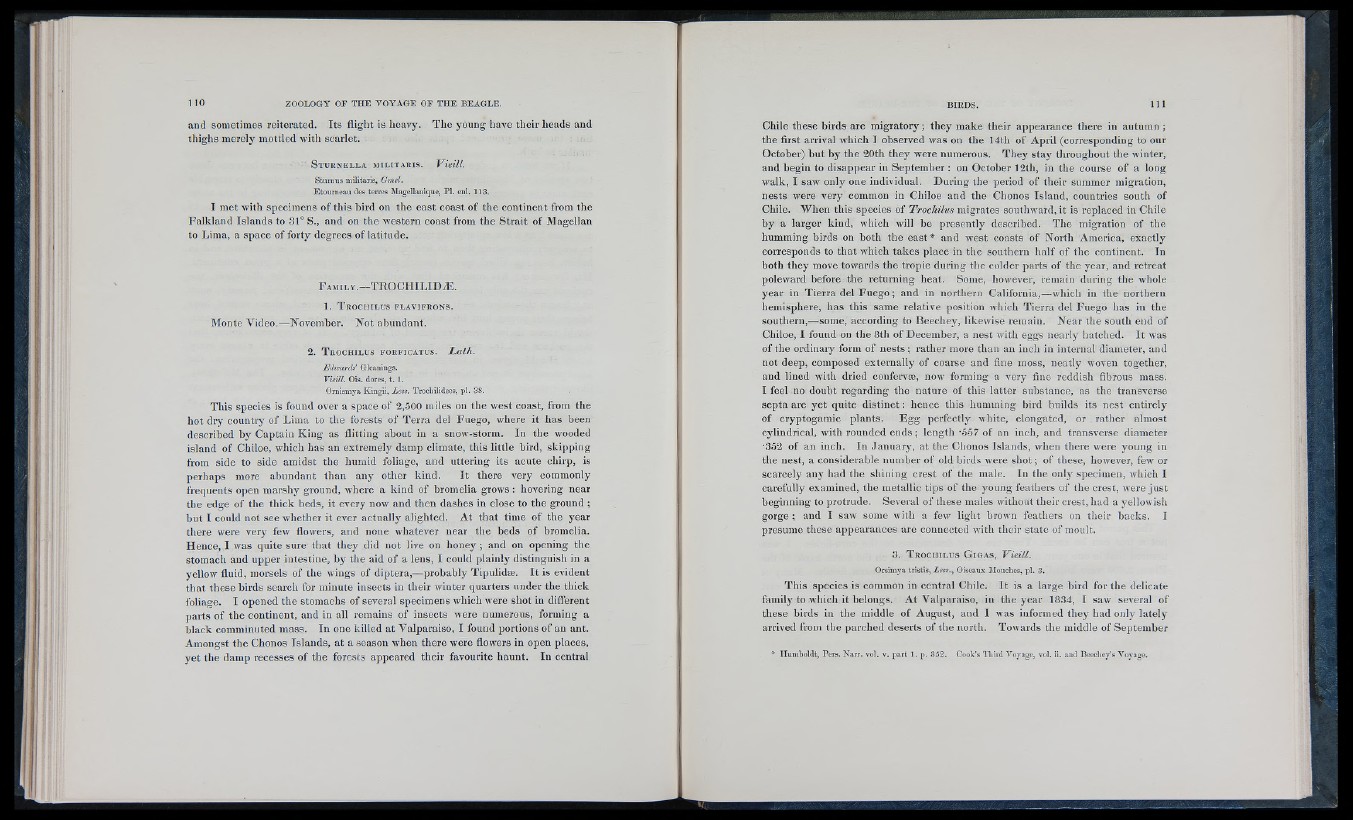
and sometimes reiterated. Its flight is heavy. The young have their heads and
thighs merely mottled with scarlet.
S t u r n e l l a m i l i t a r i s . Vieill.
Stunnis militaris, Gmel.
Etouriieaii des terres Jlagellanlque, PI. enl. 118.
I met with specimens of this bird on the east coast of the continent from the
Falkland Islands to 31° S., and on the western coast from the Strait of Magellan
to Lima, a space of forty degrees of latitude.
F a m i l y .— TROCHILID^.
1. T r o c h il x js f l a v i f r o n s .
Monte Video.—November. Not abundant.
2 . T r o c h il u s f o r f i c a t u s . Lath.
E/hcards' Gleanings.
Vieill. Ois. dores, t. 1.
Ornismya Kingii, Less. Trocliilldces, pl. 38.
This species is found over a space of 2,500 miles on the west coast, from the
hot dry country of Lima to the forests of Terra del Fuego, where it has been
described by Captain King as flitting about in a snow-storm. In the wooded
island of Chiloe, which has an extremely damp climate, this little bird, skipping
from side to side amidst the humid foliage, and uttering its acute chirp, is
perhaps more abundant than any other kind. It there very commonly
frequents open marshy ground, where a kind of bromelia grows: hovering near
the edge of the thick beds, it every now and then dashes in close to the ground ;
but I could not see whether it ever actually alighted. At that time of the year
there were very few flowers, and none whatever near tlie beds of bromelia.
Hence, I was quite sure that they did not live on honey ; and on opening the
stomach and upper intestine, by the aid of a lens, I could plainly distinguish in a
yellow fluid, morsels of the wings of diptera,—probably Tipulidee. It is evident
that these birds search for minute insects in their winter quarters under the thick
foliage. I opened the stomachs of several specimens which were shot in different
parts of the continent, and in all remains of insects were numerous, forming a
black comminuted mass. In one killed at Valparaiso, I found portions of an ant.
Amongst the Chonos Islands, at a season when there were flowers in open places,
yet the damp recesses of the forests appeared their favourite haunt. In central
Chile these birds are migratory; they make their appearance there in autumn ;
the first arrival which I observed was on the 14th of April (corresponding to our
October) but by the 20th they were numerous. They stay throughout the winter,
and begin to disappear in September : on October 12th, in the course of a long
walk, I saw only one individual. During the period of their summer migration,
nests were very common in Chiloe and the Chonos Island, countries south of
Chile. When this species of Trochilus migrates southward, it is replaced in Chile
by a larger kind, which will be presently described. The migration of the
humming birds on both the east* and west coasts of North America, exactly
corresponds to that which takes place in the southern half of the continent. In
both they move towards the tropic during the colder parts of the year, and retreat
poleward before the returning heat. Some, however, remain during the whole
year in Tierra del Fuego; and in northern California,—which in the northern
hemisphere, has this same relative position which Tierra del Fuego has in the
southern,—some, according to Beechey, likewise remain. Near the south end of
Chiloe, I found on the 8th of December, a nest with eggs nearly hatched. It was
of the ordinary form of nests; rather more than an inch in internal diameter, and
not deep, composed externally of coarse and fine moss, neatly woven together,
and lined with dried confervse, now forming a very fine reddish fibrous mass.
I feel no doubt regarding the nature of this latter substance, as the transverse
septa are yet quite distinct: hence this humming bird builds its nest entirely
of cryptogamic plants. Egg perfectly white, elongated, or rather almost
cylindrical, with rounded ends; length -oo? of an inch, and transverse diameter
*352 of an inch. In January, at the Chonos Islands, when there were young in
the nest, a considerable number of old birds were shot; of these, however, few or
scarcely any had the shining crest of the male. In the only specimen, which I
carefully examined, the metallic tips of the young featliers of the crest, were just
beginning to protrude. Several of these males without their crest, had a yellowish
gorge ; and I saw some with a few light brown feathers on their backs. I
presume these appearances are connected with their state of moult.
3. T r o c h il u s G i g a s , Vieill.
Orsimya tristis, Less., Oiscaux Mouclies, pl. 3.
This species is common in central Chile. It is a large bird for the delicate
family to which it belongs. At Valparaiso, in the year 1834, I saw several of
these birds in the middle of August, and I was informed they had only lately
arrived from the parched deserts of the north. Towards the middle of September
* Humboldt, Pers. Narr. vol. v. part 1. p. 352. Cook’s Third Voyage, vol. ii. and Beechey’s Voyage.